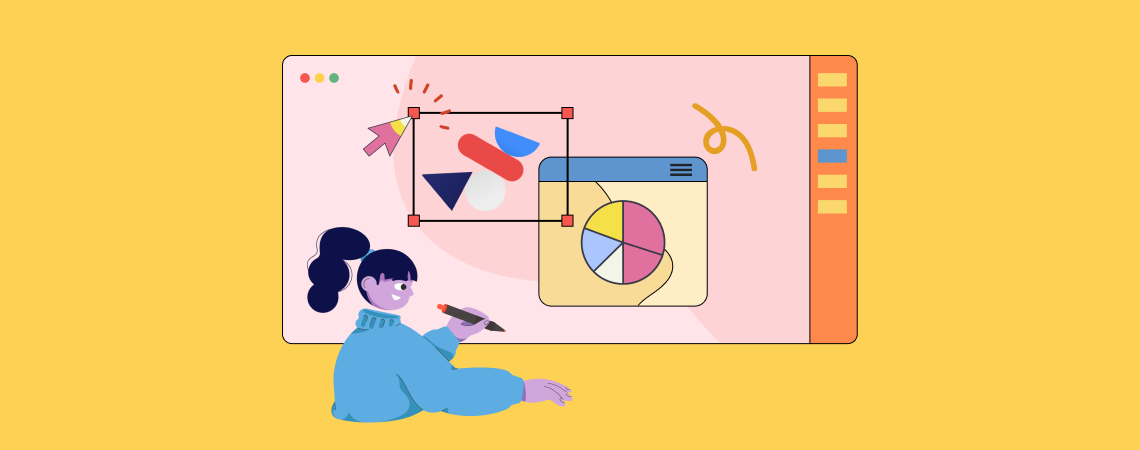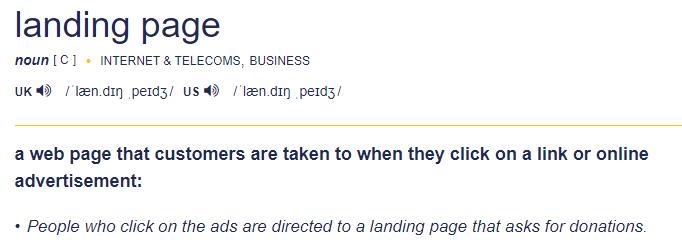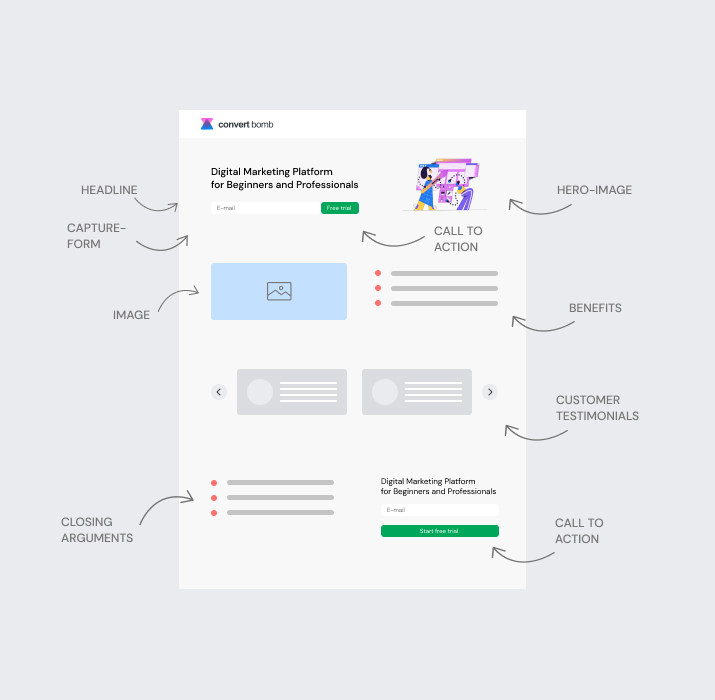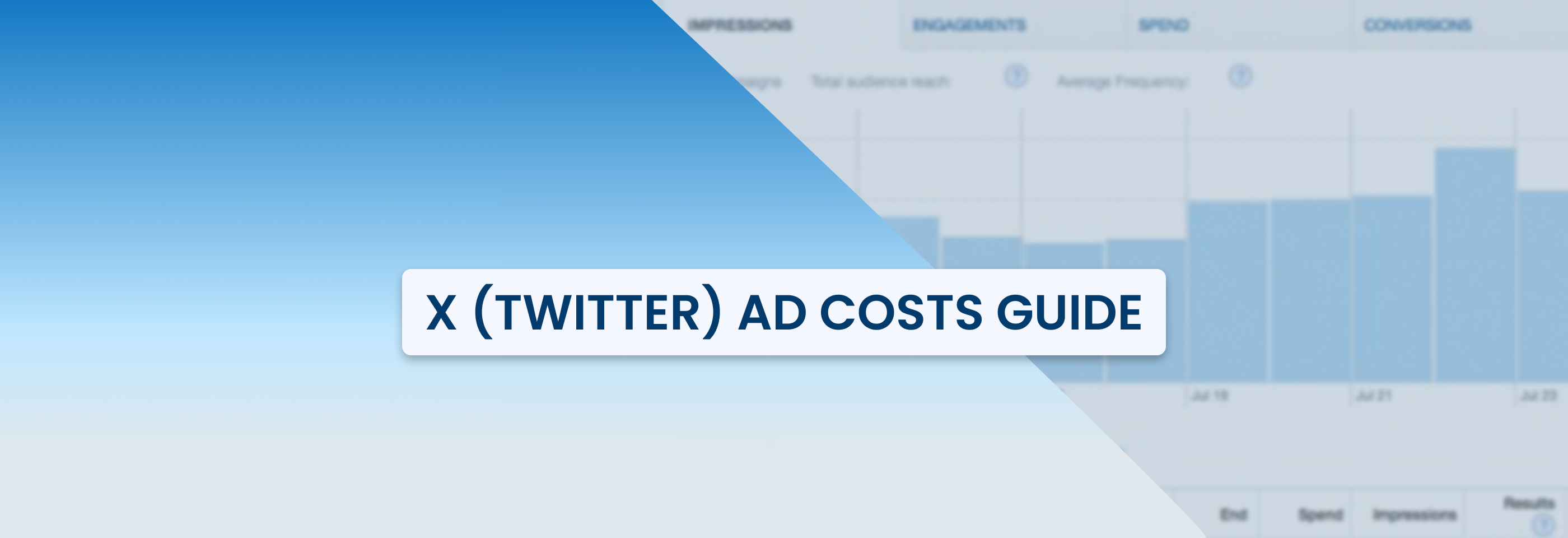How Do You Create a Landing Page That Converts?
2023-05-15

What is a landing page?
If you are interested in what a landing page is and decide to check it in a dictionary, you will see the following result:

As you can see, this definition is quite a broad one since not every link you click will take you to a landing page. Let’s take a deeper look into the issue.
A landing page is a standalone web page used for marketing and advertising. Unlike standard web pages that encourage exploration, landing pages consist of one separate page presenting you all the information you may need. Basically, it is a logical extension of the advertisement you click on.
What’s the purpose of a landing page?
Generally speaking, landing pages serve one sole purpose - to convert visitors into leads or buyers. While web pages may have many goals, landing pages are always single-focused. They must attract the visitors and motivate them to perform the necessary action, i.e. buy the product, subscribe to the newsletter, etc.
How do landing pages work?
1. First of all, people see a link with an intriguing call-to-action, click it, and end up on a landing page.
2. They fill in the necessary form and become your leads or buy the promoted product or service.
3. With the help of third-party tools such as Facebook Pixel or Google Analytics, you can see what exactly these leads were doing on your page. It is especially useful when there are several offers on your landing page.
4. Thus, the data gathered will give you more details to consider while working on these particular potential clients.
What are the benefits of using landing pages?
1. A relevant and well-arranged page can make a person purchase a product or a service within several seconds because all the details and instructions on what to do are situated in the same place. A standard website with a lot of tabs demands much more time and attention.
2. As a landing page serves a single purpose and doesn’t contain any excessive information, it is easier to focus attention on the product and make a decision.
3. While collecting leads, you also gather their demographic information. It helps you understand your audience better. That will improve the performance of your next marketing campaigns.
4. From a technical point of view, a landing page is quite easy to produce since it is a small one-page site that doesn’t weigh much. However, it still requires proper attention during the creation.
Types of landing pages
Defined by the goals you want to achieve, several types of landing pages can be distinguished:
Lead generation page serves the purpose of collecting visitors’ data. The main thing people need to do on such a page is to leave some piece of their personal information (email, phone number, etc.) in order to receive a discount, reserve a phone call, subscribe to a newsletter, or get access to some document. A good landing page to generate leads is a Download gate. To learn more about it, follow this link.
Clickthrough landing page is a page that motivates visitors to buy something. It can sell either products or services, but the final destination for visitors is the same - to make a purchase.
Brand landing page is the rarest type of all. Being completely informative, it doesn’t sell anything and doesn’t collect any data. Usually, such a type of page is used by big companies when they are going to release a new product and they want to tell the world about the upcoming event.
Landing page structure

There are several elements that you should definitely include during the landing page creation:
1. The headline and the supporting headline include just several words but you shouldn’t underestimate their value. The point is, since situated at the very top, these several words are the first thing people see after opening your page. If they are not catchy or don’t contain enough information, people won’t even scroll down to see the whole page.
2. The text of the page should be simple, concise, and convincing. A lot of text will make your page boring, while not enough of it will leave some questions unanswered and make your page look doubtful.
3. You can include the lead generation form at the beginning as well as the end of your landing page. The fewer fields the form has the easier it is to fill in.
You can include the name and the email address, or the name and the age, depending on the objective you pursue. Call-to-action should also be clear, depicting the action that is needed to be taken.
4. The list of benefits your product/service has should tell visitors how it will make their life easier and why it is better than your competitors’ offers.
5. It wouldn’t hurt to include social proof about your service. Various types of testimonials would work - grateful messages, videos, and so on. A good idea is to display the logos of the brands you’ve worked with since it will make your website look more credible.
6. The bottom of the page is a perfect place for a closing argument. Summarize all the information presented on the page. As visitors scroll down to this part, it is your final chance to convince them to make a purchase.
Landing page creation steps
1. First and foremost, decide on the goal of your page. Remember that any landing page has a sole purpose. If you want to sell something and collect data at the same time, it would be better to create two separate pages.
2. Prepare the content for your page - compelling headline, short and appealing text, appropriate images and/or videos.
3. Collect testimonials, reviews, or any kind of recommendations you have about your product or service.
4. Plan page architecture, work on the design, prepare simple navigation, choose readable fonts. The structure of the page should be logical and have a clear hierarchy, as it was outlined above.
5. Insert the page link into your Facebook or Google ads, email campaign, or place it wherever you think is appropriate. Below you will find some advice on where to put the link.
6. Keep an eye on the performance of the page and always analyze the results. Be ready for constant a/b testing.
Sources of traffic to landing pages
If you have created a page and are now struggling with where to implement the link, here are some ideas for you to consider:
- Paid advertising in search engines. Whether it is Google Ads or something else, it will be really useful since the ad will appear at the very top of the feed.
- Running ads on social media. Everyone uses at least one social media platform, so it will be a great way to target a specific audience that is initially interested in the sphere of your business.
- Email campaigns. Prepare a contact list and craft a letter with an offer, add the landing page link that covers all the details. Email campaigns have always been considered an effective channel for converting leads into customers.
- Organic search traffic. Work on SEO, investigate keywords, create useful and compelling content that will be ranked high. Unlike the options mentioned above, this one is free. However, it will take more effort and expertise.
- Collaboration with bloggers and micro-influencers. Get in touch with people creating content in your sphere and decide on terms of cooperation. Don’t leave people with just several thousands of followers in the cold. As a rule, they have a closer bond with their following base that will work for your benefit.
Common mistakes while creating a landing page
Even if your page has all the necessary elements, you are confident about the structure, text, and design, there still may be some little flaws you may have missed. We would recommend you to pay special attention to the following:
- If your page contains too much information that can be avoided without losing sense, or there are long and difficult grammar constructions, we recommend you get rid of them. Remember that people prefer everything to be as easy to comprehend as possible. They will be more likely to stay on your page if everything is clear and straight to the point.
- On the other hand, if the information is insufficient and some questions remain unanswered, it will make a negative impression. Try to balance all the details about your product or service and provide visitors with everything necessary.
- Avoid any information that is not connected with this particular product or service at all. Of course, you want your page to be as informative as possible, but it will only distract the visitors while they need to be focused on one single thing.
- Never try to deceive your potential customers. The text and the images you use must be real and true to life. Lying will not only deter people from buying, but it will also make them leave negative feedback and think of you as a fraudster.
Some extra tips for creating a landing page
If you want to make your landing page experience more sufficient, here are some tips on what to think about:
- Proofread. It will never hurt to check the text a couple of times before publishing it. Everyone may make a typo or a grammar mistake, even if they are sure about their literacy.
- If possible, make your landing page mobile-friendly. It is especially important in the modern world since mobile phones are more like tiny computers now, and most of us use them for work.
- Try to reduce the load time. If your page takes ages to load, most likely, people won’t waste time waiting. Even a several seconds delay may lead to a reduction in conversions.
Conclusion
Ideally, people who know nothing about the product see a link to the landing page, click it, skim it, and, by the time they have scrolled down to the very bottom, they have no questions or doubts and are ready to buy into your offer. We hope that with the help of our guide your landing page will work exactly like this.

